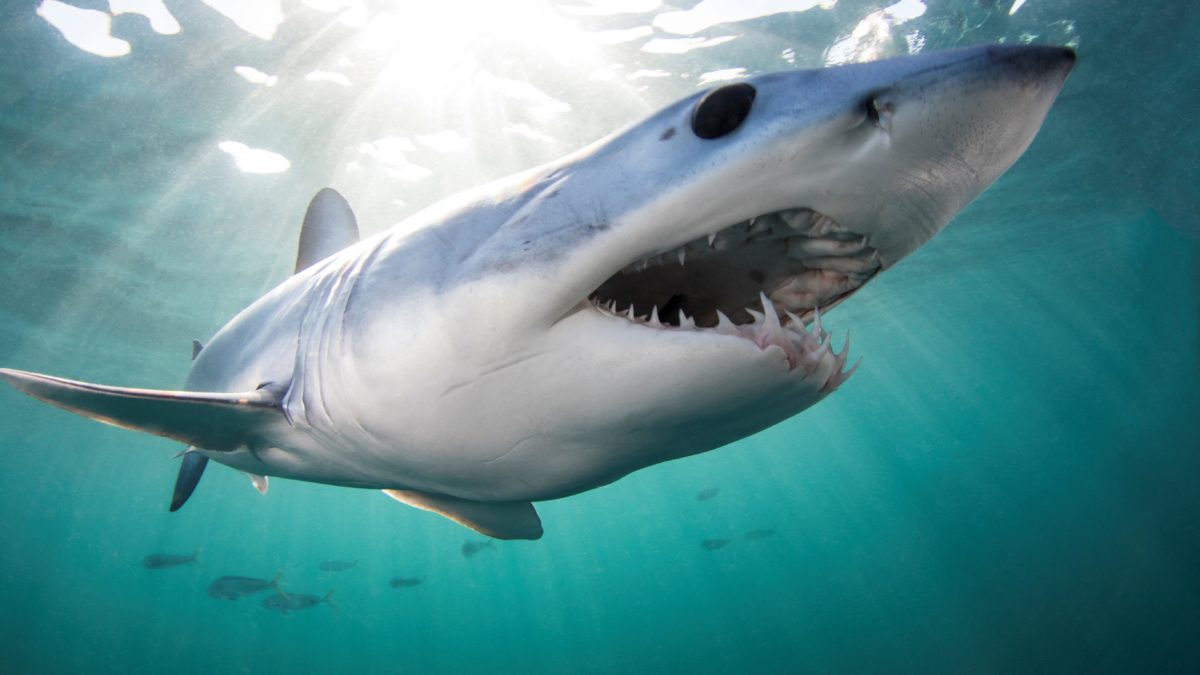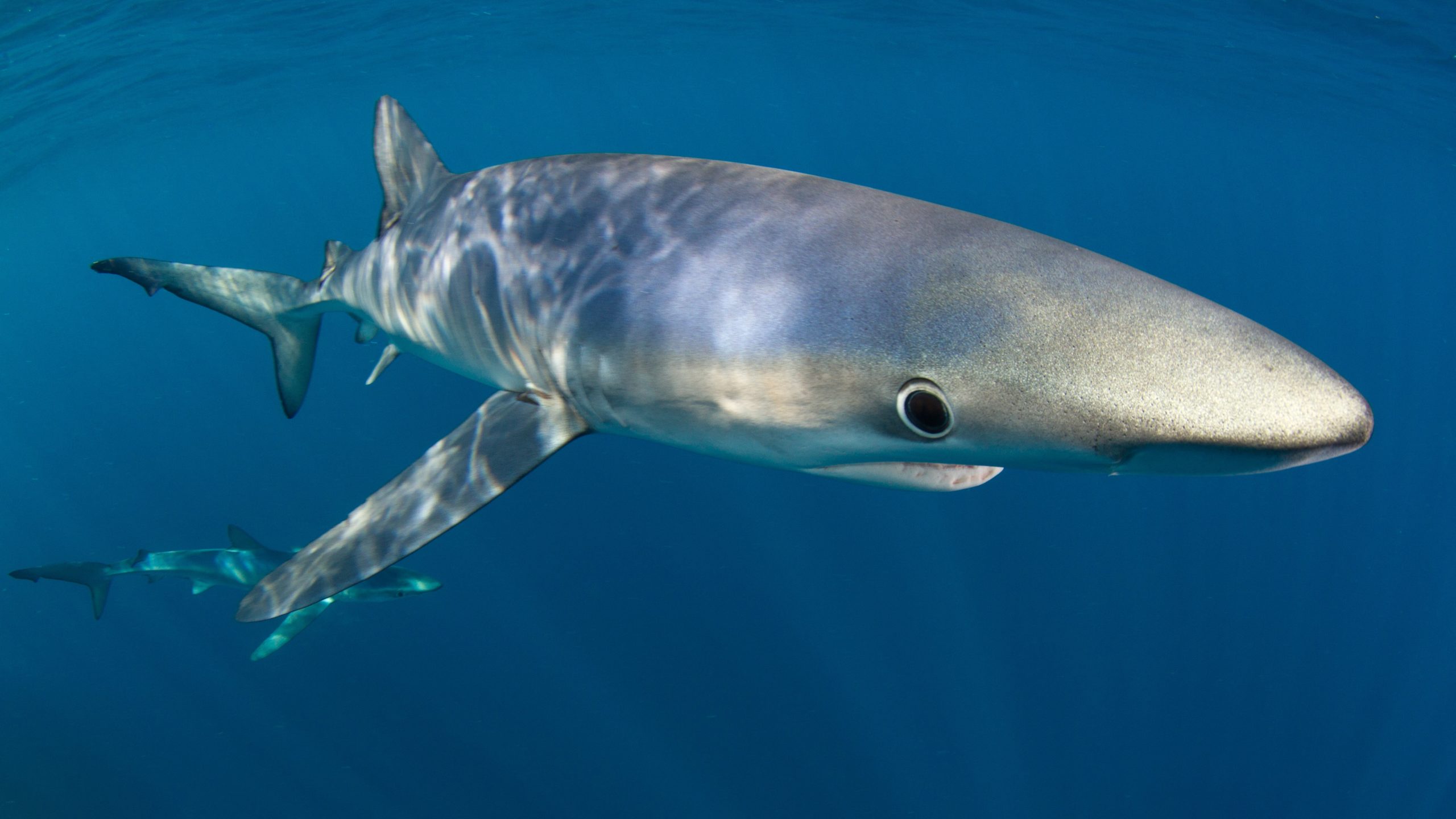Top Fish Predators Could Suffer Wide Loss of Suitable Habitat by 2100 Due to Climate Change
 A newly published study from Woods Hole Oceanographic Institution, San Diego State University, and NOAA Fisheries, shows that some species of highly migratory fish predators – including sharks, tuna, and billfish, could lose upwards of 70% of suitable habitat by the end of the century, which is when climate driven changes in the ocean are projected to increase between 1-6°C (+1-10°F) in sea surface temperatures. The study identified the Northwest Atlantic Ocean and the Gulf of Mexico, which are among the fastest warming ocean regions, as predicted hotspots of multi-species habitat loss. (Photo ©Tom Burns)
A newly published study from Woods Hole Oceanographic Institution, San Diego State University, and NOAA Fisheries, shows that some species of highly migratory fish predators – including sharks, tuna, and billfish, could lose upwards of 70% of suitable habitat by the end of the century, which is when climate driven changes in the ocean are projected to increase between 1-6°C (+1-10°F) in sea surface temperatures. The study identified the Northwest Atlantic Ocean and the Gulf of Mexico, which are among the fastest warming ocean regions, as predicted hotspots of multi-species habitat loss. (Photo ©Tom Burns) August 9, 2023
The impacts of climate change on habitats are already evident
Woods Hole, MA — A study of 12 species of highly migratory fish predators—including sharks, tuna, and billfish such as marlin and swordfish—finds that most of them will encounter widespread losses of suitable habitat and redistribution from current habitats in the Northwest Atlantic Ocean (NWA) and the Gulf of Mexico (GOM) by 2100. These areas are among the fastest warming ocean regions and are projected to increase between 1-6°C (+1-10°F) by the end of the century, a sign of climate-driven changes in marine ecosystems.
In some cases, these iconic, and economically and ecologically important species, could lose upwards of 70% of suitable habitat by the end of the century, and in most cases, the impacts of these climate-induced changes are already observable.
NOAA CoastWatch visualization of NOAA satellite data for global sea surface temperatures from January 2023 through July 2023. (Video by NOAA Satellites)
“The ongoing and projected effects of climate change highlight the urgent need to adaptively and proactively manage dynamic marine ecosystems,” according to the study, “Widespread habitat loss and redistribution of marine top predators in a changing ocean,” published in the journal Science Advances.
The study, led by Camrin Braun, an assistant scientist and marine ecologist at the Woods Hole Oceanographic Institution (WHOI), identified areas offshore of the Southeast U.S. and Mid-Atlantic coasts as predicted hotspots of multi-species habitat loss. The researchers studied the impacts on three shark (blue, porbeagle, and shortfin mako), five tuna (albacore, bigeye, bluefin, skipjack, and yellowfin), and four billfish (sailfish, blue marlin, white marlin, and swordfish) species. Although the researchers’ model framework could not account for potential adaptability or thermal tolerance by species, the results “suggest predominant and widespread habitat loss for nearly all [highly migratory species] studied.”
“Climate change is expected to fundamentally change the status quo for where these species are and how they live. While we don’t really understand all the details of what that fundamental change might look like, this study is a good step in the direction of trying to nail down what those changes might be, so that we can do something about it,” said Braun.
Scientists used three decades of satellite, oceanographic model, and in situ biological data to develop dynamic species distribution models to assess how climate change has already and will continue to impact the fish species in the NWA and GOM.
“Our research demonstrates that climate-driven changes are happening now, not from projections of climate change, but based on observed empirical data from the last two decades. So while our findings do point to larger species shifts in the near term, it also clarifies the substantial changes in species distributions that have already occurred,” said study co-author Rebecca Lewison. She is professor of biology and a conservation ecologist at the Coastal and Marine Institute at San Diego State University. She added that the research results “highlight the importance of using NASA and other satellite data to understand how a changing ocean is impacting commercially important marine species like swordfish and tunas.”
The study “not only sheds more light on the far-reaching effects of climate change on ocean environments but highlights that marine conservation and management efforts need to plan for these ongoing changes. If migratory fish are on the move, fishing vessels and coastal communities will also need to adapt. Studies like this will help marine resource agencies be even more dynamic in their decision-making,” said study co-author Tobey Curtis, a fishery management specialist in the Atlantic Highly Migratory Species Management Division of NOAA Fisheries.
The shifts in the habitat and distributions of these species “raise concerns for associated fisheries and the socioeconomic impacts of climate change on fishing communities,” according to the article. The concentrated changes in species distribution also “highlight the need for adaptive management approaches that can respond to expected changes.” “Our results suggest static fishery management measures will continue to lose ecological relevance and economic efficacy as species redistribute under climate change.” Braun said the motivation for the research is not only to better understand the fish and marine ecosystems, but also to understand how changes affect people, their livelihoods, coastal communities, and commercial fisheries.
“We are doing our best to try to figure out what will happen, so that people can adapt and so that we can develop climate-resilient or climate-ready management policies,” Braun said.
He said that historic ways to manage fisheries are static, even though fish move around a lot. “We basically draw a box in the ocean and say whether you can or can’t fish there,” he said. Dynamic ocean management frameworks “must embody expected changes. Otherwise, you are left with your static box in the ocean that doesn’t move, even though the fish may have moved, and the ocean may have changed.”
Funding for this research was provided by a NASA Ecological Conservation program grant, the NOAA Integrated Ecosystem Assessment Program, the Postdoctoral Scholar Program at WHOI, and the Dr. George D. Grice Postdoctoral Scholarship Fund at WHOI.
###
Authors: Camrin D. Braun1 *, Nerea Lezama-Ochoa2,3, Nima Farchadi4, Martin C. Arostegui1, Michael Alexander5, Andrew Allyn6, Steven J. Bograd2, Stephanie Brodie2,3, Daniel P. Crear7, Tobey H. Curtis8, Elliott L. Hazen2,3, Alex Kerney6, Katherine E. Mills6, Dylan Pugh6, James D. Scott5,9, Heather Welch2,3, Riley Young-Morse6, and Rebecca Lewison4
Affiliations:
1Biology Department, Woods Hole Oceanographic Institution, Woods Hole, MA, USA
2Environmental Research Division, Southwest Fisheries Science Center, National Oceanic and Atmospheric Administration, Monterey, CA, USA
3Institute of Marine Sciences, University of California, Santa Cruz, Santa Cruz, CA, USA
4Institute for Ecological Monitoring and Management, San Diego State University, San Diego, CA, USA
5NOAA Earth System Research Laboratory, Boulder, CO, USA
6Gulf of Maine Research Institute, Portland, ME, USA
7ECS Federal, in Support of National Marine Fisheries Service, Atlantic Highly Migratory Species Management Division, Silver Spring, MD, USA
8National Marine Fisheries Service, Atlantic Highly Migratory Species Management Division, Gloucester, MA, USA
9Cooperative Institute for Research in Environmental Sciences, University of Colorado Boulder, Boulder, CO, USA
About Woods Hole Oceanographic Institution
The Woods Hole Oceanographic Institution (WHOI) is a private, non-profit organization on Cape Cod, Massachusetts, dedicated to marine research, engineering, and higher education. Established in 1930, its primary mission is to understand the ocean and its interaction with the Earth as a whole, and to communicate an understanding of the ocean’s role in the changing global environment. WHOI’s pioneering discoveries stem from an ideal combination of science and engineering—one that has made it one of the most trusted and technically advanced leaders in basic and applied ocean research and exploration anywhere. WHOI is known for its multidisciplinary approach, superior ship operations, and unparalleled deep-sea robotics capabilities. We play a leading role in ocean observation and operate the most extensive suite of data-gathering platforms in the world. Top scientists, engineers, and students collaborate on more than 800 concurrent projects worldwide—both above and below the waves—pushing the boundaries of knowledge and possibility. For more information, please visit www.whoi.edu
About San Diego State University
San Diego State University is a major public research institution that provides transformative experiences for its more than 36,000 students. SDSU offers bachelor’s degrees in 96 areas, master’s degrees in 84 fields and doctorates in 23 areas, with additional certificates and programs at regional microsites. SDSU ranks as the number 1 California State University in federal research support, as one of the top public research universities in California. In addition to academic offerings at SDSU, SDSU Imperial Valley and SDSU Georgia, SDSU Global Campus offers online training, certificates, and degrees in areas of study designed to meet the needs of students everywhere. Students participate in transformational research, international experiences, sustainability and entrepreneurship initiatives, internships and mentoring, and a broad range of student life and leadership opportunities. SDSU is committed to inclusive excellence and is known for its efforts in advancing diversity and inclusion. SDSU is nationally recognized for its study abroad initiatives, veterans’ programs, and support of LGBTQA+ students, as well as its powerhouse Division I Athletics Program. More than 50% of SDSU’s undergraduate and graduate students are students of color. The university resides on Kumeyaay land and was most recently recognized as an Asian American Native American Pacific Islander-Serving Institution (AANAPISI). SDSU is also a long-standing Hispanic-Serving Institution (HSI). The university’s rich campus life and location offers opportunities for students to lead and engage with the creative and performing arts, career, and internship opportunities with SDSU’s more than 491,000 living alumni, and the vibrant cultural life of the greater San Diego and U.S.- Mexico region.
Media contacts:
Suzanne Pelisson
Director, Public Relations, Woods Hole Oceanographic Institution
SPelisson@WHOI.edu
Cory Marshall
Senior Director of Media Relations, San Diego State University
Cory.Marshall@sdsu.edu
Lauren Gaches
Director, Public Affairs, National Marine Fisheries Service
nmfs.pa@noaa.gov
Key Takeaways
- A study of 12 species of highly migratory fish predators—including sharks, tuna, and billfish such as marlin and swordfish—finds that most of them will encounter widespread losses of suitable habitat and redistribution from current habitats by 2100. That is when ocean surface temperatures are projected to increase between 1-6°C (+1-10°F), a sign of climate-driven changes in marine ecosystems.
- In some cases, these iconic and economically- and ecologically important species could lose upwards of 70% of suitable habitat by the end of the century. In most cases, the impacts of climate change on habitat already are observable.
- In most cases, the impacts of climate change on habitat already are observable.
- “The ongoing and projected effects of climate change highlight the urgent need to adaptively and proactively manage dynamic marine ecosystems,” according to the study. “Our results suggest static fishery management measures will continue to lose ecological relevance and economic efficacy as species redistribute under climate change.”
- The study identified the Northwest Atlantic Ocean and the Gulf of Mexico, which are among the fastest warming ocean regions, as predicted hotspots of multi-species habitat loss.
- The motivation for the research is not only to better understand the fish and marine ecosystems, but also to understand how changes affect people, their livelihoods, coastal communities, and commercial fisheries, said journal article lead author Camrin Braun. “We are doing our best to try to figure out what will happen, so that people can adapt and so that we can develop climate-resilient or climate-ready management policies.”
- “Climate change is expected to cause the status quo for where these species are and how they live to fundamentally change. While we don’t really understand all the details of what that fundamental change might look like, this study is a good step in the direction of trying to nail down what those changes might be, so that we can do something about it,” said journal article lead author Camrin Braun

